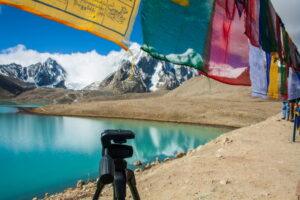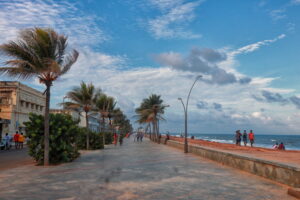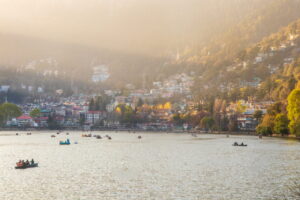Well! That’s partially true. I did see a deer for a second. And on the very next moment, it disappeared behind the trees before I could ask my family to see it. Even the driver, who was also our local guide in the jungle, could not spot it.
So, for the rest of us in that 4×4 Bolero, it was just a bluff. Jayeeta started repenting that the whole safari went useless and concluded that our time in Simlipal National Park was more memorable, which I did not deny. But, I felt awkward when our driver cum guide started questioning about it.
“Sir, did you see it actually,” he asked. “what colour was it?”
“Blackish!!”
“Are you sure it was an animal?” he said, “I did not see any black deer here, ever.”
“Yes, I mean, it was in the shadow, so probably looked blackish. But, it was there.” I confirmed.
To be very honest, I was not expecting many animal sightings either. I understand that entering a forest after 10 in a late March morning eliminates the possibilities of animal sighting. But, man, that does not mean I will create one in my imagination!!

I did not need to construct anything that I saw in the last one and a half hours before I finally spot a sambar deer! Even in my wildest dream, I did not imagine that I could watch forest fires in Kuldiha Wildfire Sanctuary. I did not imagine that I would see burning flames, smell the ashes and feel the warmth of the fire in a forest. No, I could not hear the sound of the jungle here. The burning nature did not produce a sound; it just turned to ashes in despair.
But I was not cynical!! Because of this thing, these forest fires, maybe it is the first time for my family and me to watch one, but it is prevalent in India. Almost one-seventh of the entire forest area in India is prone to wildfires, a recent report from Forest Survey in India (FSI) says. And the states most affected are Chattisgarh, Madhya Pradesh, Odisha, Manipur and Mizoram. As per the survey, 29547 fires are detected in 2019 using a Moderate Resolution Imaging Spectroradiometer sensor.
And then, when I searched for an answer, everything leads to one direction – global warming. Climate change which is the most often discussed topic nowadays and that should be, is the evil behind all the natural disaster throughout the world; forest fires are no exception. Kids do not need to be a Greta Thunberg to understand this; leave aside the politicians and bureaucrats.
But you know, our driver cum guide in Kuldiha Forest was not very aware of this global warming thing. He thought these fires are due to local problems that could be prevented. He is not a global person, and his thoughts were not global too!! All he knew that if every local administration could take care of his local problems, then there will not be many global hazards to solve.

So, he was more concerned about the poachers and the villagers. Locals burn the dry leaves in the jungle to collect the Mahua fruits because that will keep the poisonous insects and snakes away. For them collecting Mahua, drying it and making the local country liquor out of it is a way of living during spring and summer, the non-farming months. In contrast, poachers do it to abolish the sound of walking on dry leaves so that animals do not become alert and flee. Poaching is a crime that still exists here, even after all the strict rules and vigilant eyes.
These two problems are there since Kuldiha gets the privilege of a wildlife sanctuary, and they still persist. So, for us and many alike tourists every year, it was not uncommon to see many stretches of burnt forests since we crossed Balianal Gate. Even the core forest area was not out of it. While writing this article, a new forest fire broke out in Kuldiha Wildlife Sanctuary, raging across several hills, burning down the trees and plants to ashes.
So, until the administration raises the concern and shifts the focus towards the local problem and stops blaming global alarming for everything, these disasters will happen in a frightening number every year throughout the country. It’s high time we must understand that forests need only conservation, not to be treated as potential sources of revenue.
How to reach Kuldiha Wildlife Sanctuary
By road
The distance between Bhubaneswar, the capital of Odisha, to Kuldiha forest is 230 kilometres. From Kolkata, Kuldiha Wildlife Sanctuary is 290 kilometres away. From both the cities, you have to drive along a national highway until Balasore. Then take a turn to SH19 and drive till Sajangarh crossing Nilagiri town. Form Sajanagarh, one has to leave the state highway and follow village roads to reach Balianal Gate, the entry point of Kuldiha Wildlife Sanctuary. From Balasore, Kuldiha Forest is nearly 45 kilometres.
By rail
The nearest railhead of Kuldiha Forest is Balasore. Balasore is 206 kilometres from Bhubaneswar and 220 kilometres away from Howrah,
By air
Bhubaneswar (Biju Pattanayak International Airport) is the nearest airport to Kuldiha.

Where to stay in Kuldiha Forest
The only place to stay inside Kuldiha Forest is the Rissia Nature Camp in Gohirabhola beside Rissia Dam. This property has nine tented accommodations. All tents are double bedded with an attached bathroom in a separate tent. The electricity is solar-powered. There is a small children park area, a garden and a parking area in this eco-resort. Food is essentially Indian cuisine and is served in the Dining Hall. The property is surrounded by a trench and electric fencing at the perimeter. Guests can enjoy jungle walk, birding with an experienced guide and boating in Rissia Dam.
How to book Rissia Nature Camp in Kuldiha Forest?
You can book Rissia Nature Camp through the ecotourism website of Odisha Forest Development Corporation. First, select Rissia Nature Camp from “Destinations” in the main menu and then click on the “Bookings” tab to proceed further. You can email rissia.naturecamp@gmail.com for any queries.
When to visit Kuldiha Forest
The best time to visit Kuldiha Wildlife Sanctuary is from November-February. From March-May, animal sighting is less due to extreme heat. In monsoon, the forest remains closed to tourists.
Other necessary information
Entry permit
Tourists have to get their entry permits from Forest Range Office at Nilagiri. It can be obtained on the spot with an identification document. The car and driver details are also necessary while procuring permits.
Entry time
9 am – 6 pm (all days)
Entry fee
₹40 per person, a fee for my still camera, and an unbilled fee of ₹100 per car have to be submitted in the range office (reason unknown).
Watchtowers
- Kuldiha
- Jodachua
- Chemcheta (it was closed during our visit due to a trace of tiger movements in this range.)

Book your trip: Resources
- Flight
Use Skyscanner or Google Flights to book your flight.
- Accommodation
Tripadvisor and Agoda are perfect for booking your hotel. If you want to stay in a hostel, then Hostelworld would greatly help you find one at your convenience.
- Travel Insurance
World Nomads is perfect for travel insurance. You can get comprehensive protection from them. Let them take care of unexpected situations while you concentrate on your trip.
- Package Tour and Activities
You can book a package tour from G-Adventures and Viator. They are a reputed company arranging small group tours and customising them per your requirements. You can also use Get Your Guide to book your private transport, city tours, heritage walks, food walks and other experiences like a cooking lesson or a Yoga session.
Disclosure: Some of the links below are affiliate links. You will be directed to another third-party website when you click those links. If you purchase anything via those links, I will earn a referral bonus without any extra cost to you.










Sir, very nice blog and nice details.
There is very unique village retreat at chandanpur (10km from puri) named “selanidingo”. Near the river “Bhargavi”. The retreat have private catamaran boat with boatman. Here serve the different ageold traditional odiya food at its dinning hall. Please welcome once.
For more details please contact my mob. / whats app no : +91- 94******39
Thank you. Your property looks beautiful. The catamaran ride on the river seems very interesting too. 🙂
Pingback: Chandipur in Odisha | A weekend beach destination with the "Vanishing Sea" - My Travel Frames